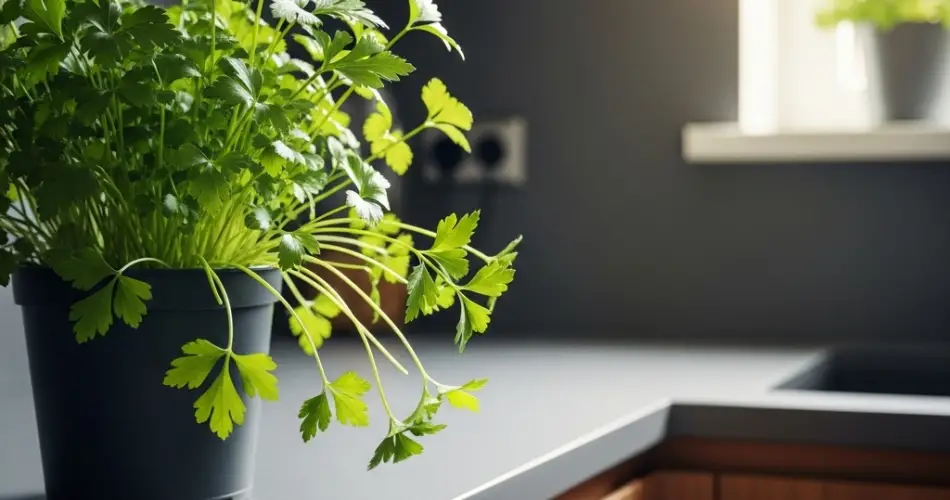You don’t need a backyard, garden bed, or even a balcony to enjoy fresh herbs at home. With a little creativity and the right know-how, you can grow vibrant, flavorful parsley in even the smallest apartment. This versatile herb not only brings life to your dishes but also adds lush greenery to your indoor spaces, making it a great plant for both culinary and decorative purposes.
If you’ve always thought gardening was reserved for those with outdoor space, it’s time to rethink what’s possible. Here’s how you can grow and enjoy parsley year-round—even with just a sunny windowsill.
Why Parsley?
Parsley (Petroselinum crispum) is one of the most beginner-friendly herbs to grow at home. It’s compact, low-maintenance, and perfect for container gardening. There are two main types:
-
Curly-leaf parsley: More decorative, often used as a garnish.
-
Flat-leaf parsley (Italian parsley): Stronger flavor and preferred for cooking.
Both types can thrive indoors with the right conditions, and each brings its own beauty and usefulness to your living space.
Choosing the Right Location
Parsley loves light—but not necessarily direct sunlight all day long. A bright windowsill that gets at least 4 to 6 hours of indirect sunlight is ideal. South- or east-facing windows work best.
No windows with good light? No problem. LED grow lights are affordable and compact, making them perfect for apartments. Even a small desk lamp with a full-spectrum bulb can keep your parsley happy.
Picking a Pot and Soil
Since parsley has long taproots, you’ll need a deep container—at least 6 to 8 inches deep. Ensure the pot has drainage holes, as parsley doesn’t tolerate soggy soil.
For best results:
-
Use a light, well-draining potting mix.
-
Mix in a little compost or organic matter to enrich the soil.
-
Avoid garden soil—it’s often too dense for container plants and may bring pests indoors.
A terracotta or plastic pot works well. Even recycled containers like yogurt tubs or tin cans can work in a pinch—as long as you poke drainage holes at the bottom.
Starting Parsley from Seed or Seedlings
You can start parsley from either seeds or store-bought seedlings. If you’re short on time or want quicker results, opt for seedlings. If you enjoy the process of growing from scratch, seeds are economical and rewarding.
To grow from seed:
-
Soak seeds in warm water for 12–24 hours before planting to speed up germination.
-
Plant them 1/4 inch deep in moist soil.
-
Keep the soil evenly damp and warm (around 70°F or 21°C) until germination, which can take 2–4 weeks.
Once the seedlings emerge, thin them to allow 3–4 inches of space between each plant.
Watering and Feeding
Indoor parsley requires consistent moisture. Keep the soil damp but never soggy. Stick your finger into the soil—if the top inch is dry, it’s time to water.
Tips for success:
-
Water slowly and deeply to reach the roots.
-
Don’t let the plant sit in standing water—empty saucers if needed.
-
Mist occasionally to add humidity, especially in winter when indoor air is dry.
Feed your parsley every 3–4 weeks with a diluted liquid fertilizer or compost tea to keep the leaves lush and green.
Harvesting Without Harming the Plant
Once your parsley reaches 6 inches in height, it’s ready to harvest. To encourage more growth:
-
Cut the outer stems first, near the base.
-
Leave the center intact so new shoots can continue to grow.
-
Never remove more than one-third of the plant at once.
Regular harvesting encourages bushier growth and extends the plant’s productivity.
Indoor Styling and Companion Planting
Parsley isn’t just functional—it’s also beautiful. Its vibrant green leaves can add life to kitchens, windowsills, or even vertical planters on a wall.
Consider pairing parsley with other small herbs like basil, thyme, or chives in a shared container. Not only does this save space, but it also creates a mini herb garden that’s visually appealing and incredibly useful for cooking.
Extending the Life of Your Plant
Parsley is a biennial, meaning it lives for two years. In its second year, it may flower and go to seed. If this happens indoors:
-
You can trim flower stalks to prolong leaf production.
-
Or let it go to seed and start a new crop.
You can also sow a new batch of seeds every few months to maintain a continuous harvest without interruption.
Final Thoughts
You don’t need a garden to grow your own food. A pot, a sunny spot, and a bit of care are all it takes to turn your apartment into a productive herb haven. Parsley is the perfect starter herb for city dwellers and beginners alike. It rewards minimal effort with fresh flavor, bright greenery, and the satisfaction of growing your own.
So whether you’re working with a narrow kitchen ledge or a makeshift shelf by the window, you can transform your living space into a mini-garden—with parsley leading the way.



